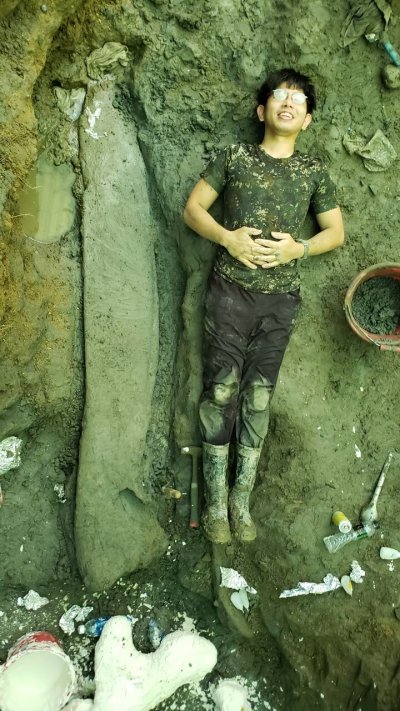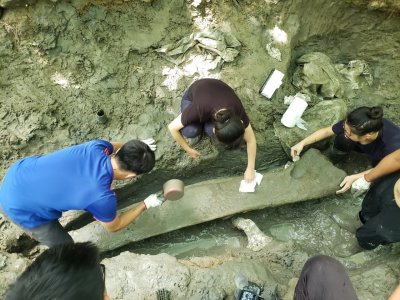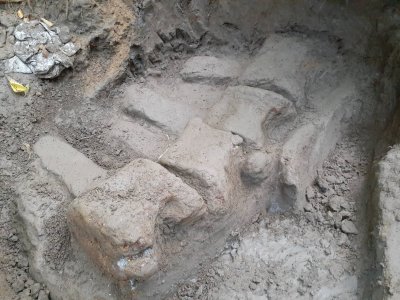Prehistoric 50-Foot Whale Discovered in Deep Jungle Valley by Accident
BY JESS THOMSON ON 12/6/22
Research Team Uncovers 50-Foot Whale Skeleton Fossil
A nearly complete ancient whale skeleton measuring 50 feet long has been discovered in Taiwan, the most complete whale specimen ever found on the island.
In May, Zhou Wenbo, one of the members of the whale fossil excavation team from the National Cheng Kung University's Archaeological Institute, was searching for fossils with local fossil collector Zhang Yumu when they found four of the whale's ribs sticking out of the ground deep in a jungle valley. After some initial excavation, they contacted Yang Zirui at the university.
The fossil, which turned out to be nearly 70 percent complete, is estimated to be that of a blue whale or "big fin whale" that lived around 85,000 years ago. The whale's shoulder blades, jawbone, back side of the skull and tail vertebrae are all well preserved, a National Cheng Kung University release said.

Pictured are students and researchers from Taiwan's National Cheng Kung University and the National Science and Technology Museum, who unearthed the most complete whale fossil found in the nation's history, at 50 feet long.
NATIONAL CHENG KUNG UNIVERSITY/NATIONAL SCIENCE AND TECHNOLOGY MUSEUM/YANG ZIRUI
Whales evolved from land animals, splitting off from hippos, their common ancestor, about 50 million years ago. Blue whales, the largest creature to ever exist, can grow up to 98 feet, with fin whales close behind at a record 85 feet long. The earliest specimen of modern blue whales ever found was identified from a skull fossil in Southern Italy, and these creatures were thought to have lived 1.5 million to 1.25 million years ago. Blue and fin whales are considered related evolutionarily as humans are to gorillas, having evolved into separate species from their common ancestor about 3.5 million years ago.
The Tougou area in Hengchun is a fossil hotspot, and many fossils from shells, sharks, crabs and whalebone have been found there, Zhou said.
1 of 4

A student lies next to the 7-foot jawbone
.NATIONAL CHENG KUNG UNIVERSITY/NATIONAL SCIENCE AND TECHNOLOGY MUSEUM/YANG ZIRUI
The 50-foot specimen was excavated in Hengchun by Yang, an assistant professor at the Department of Earth Sciences at National Cheng Kung University, as well as other researchers from there and the National Museum of Natural Science and several students from the Chengdu University of Technology.
The Taiwan fossil was excavated over 90 days and carried on foot back to the university, where it was stored at the National Museum of Natural Science. According to the release, the heaviest whale jawbone "weighed 334 kilograms [736 pounds] and was 223 centimeters [7.3 feet] long."
Zhuang Jingren, a rescue volunteer, said in the release that he had never seen jawbones longer than 3.2 feet. Eight people carried the bones on wooden stretchers over rugged terrain and through dense vegetation.
The university said the skeleton represented the second-largest mammal fossil found in Taiwan after some rhino fossils were discovered in 1971. The hayasaka rhino skeletons were found in Tainan's Zuojhen District and are specimens of a rhino species believed to have lived only in Taiwan in the Pleistocene Epoch, between 2.5 million and 11,700 years ago. A near-complete skeleton of Nesorhinus hayasakai is on display in Tainan City Zuojhen Fossil Park.
The geology team at the science museum will continue to clean the whalebone specimens. The scientists hope that further research into the fossils will "help to understand how whales adapt to environmental changes from the ice age to the present."

The excavation team carefully removed water and dirt from a mandible fossil before plastering it.

Whale scapula fossils are cast in plaster.
Pictured are the whale vertebral fossils.
NATIONAL CHENG KUNG UNIVERSITY/NATIONAL SCIENCE AND TECHNOLOGY MUSEUM/YANG ZIRUI
READ MORE

















